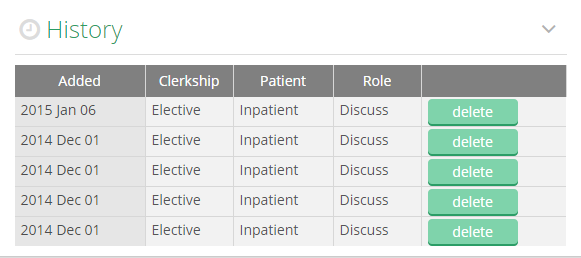Overview
The Essential Clinical Experiences Tracker (ECE Tracker) is used to monitor the core experiences that must be completed by every clerk in the Undergraduate MD Program. The ECE Tracker can be found in medportal under the Clerkship Menu options. The URL for the Tracker is http://www.medportal.ca/ug/ece
Adding an ECE
- Quick Add
To log an ECE at the default patient type and role (as listed below the ECE title) for your selected clerkship, press the + icon next to its name.
- Changing the role or patient type for an experience
To log an ECE at a different patient type and role than the default, click the ECE name, a details view should appear, then change the default parameters in the dropdowns, and click "Add Encounter".

- Changing the clerkship, rotation or site
You can also change the clerkship, rotation or site by clicking on 'Edit' in the top right hand corner and selecting the appropriate information from the drop down boxes.

Deleting an ECE
If you make a mistake or want to review past logs of an ECE, select the ECE name and you will see a list of ECE logs at the bottom right. You can delete a log instance by clicking the delete button next to it.

Performing a search
To find a specific ECE, type a partial match into the search box and press enter. The default search will only search the list of experiences for the current rotation. To search the complete list of experiences click the infinity symbol and then perform a keyword search.
You can expand or narrow down the list of ECEs or ECE types by selecting from the filters on the left, or the ECE types underneath the ECE search box.
Defining 'Roles' and 'Patient Type'
Each experience listed in the Tracker has been assigned a specific role and patient type as defined by each clerkship. It is possible for a single experience to be met in more than one clerkship, but if the role or patient type requirements differ between clerkships, the experience may have to be completed again in subsequent clerkships. Please see the definition of each role and patient type below:
Roles
Roles can be viewed in an hierarchical order. 'Discuss' is the lowest level. 'Observe' implies that you have also discussed the ECE with your clinical preceptor and as such also completes the 'Discuss' requirement. 'Manage' and 'Demonstrate' implies 'Observe' and 'Discuss', but do not imply the other. If you have both Demonstrated and Managed the same ECE, log it twice with the appropriate role.
- Discuss
- the student has been involved in a thorough discussion regarding a case of the specific disorder with their preceptor/tutor/faculty member
- Observe
- the student has observed a patient's presentation/management of the specific disorder
- Demonstrate
- the student has performed the required tasks (eg history, examination, procedure) related to the specific presentation
- Manage
- the student has managed a patient's case for the specific disorder at the level appropriate for a clinical clerk
Patient Types
Computer (C)- an experience completed via an online learning module or other computer application.
- House Visit (H)
- a patient who is visited in the home
- Inpatient (I)
- a patient who has been admitted to the hospital
- Long Term Care (LTC)
- a patient who is visited in a Long Term Care facility
- Not Applicable (NA)
- this only applies to experiences that do not involve a patient (i.e: Communicate with other members of the health care team.)
- Outpatient (O)
- a patient who visits a hospital or health care provider for diagnosis or treatment
- Paper Case (P)
- an experience completed via a paper-based case/problem
- Simulated Patient (SP)
- a person trained to act as a real patient in order to simulate a set of symptoms or problems
- Simulator (S)
- an experience completed in a simulated environment
Types of ECEs
Experiences can be classified into three major categories: primary presentations, procedures and professional competencies (see below). The list of presentations can be filtered by these categories.
Primary Presentations
Core diseases, emergencies, and conditions that clerks will encounter during their clerkship phase.
Procedures
Procedures cover clinical tasks that can range from performing specific examinations (i.e. Pelvic exam) to applying a splint/cast.
Professional Competencies
Pro Comp experiences can be completed in ANY clerkship. These have been created so that students can complete them in any rotation but some of the experiences will likely happen in specific rotations. For example: Participate in the completion of Mental Health Act forms will most likely occur in your Psychiatry rotation but can be accomplished in other rotations as well.
Notes
In full logging mode (accessible by clicking the ECE title), students can add notes to their encounter logs. These notes will appear on printed reports and can be useful for reference or to communicate specifics about the case to preceptors or administrators. Unless otherwise specified by your clerkship, filling in the notes field is not required. Please note that the field is limited to 500 characters. More detail than that should never be necessary in the context of the ECE Tracker.
Reports
PDF reports can be generated for overall progress or for progress of each individual clerkship. On the bottom right hand side of the Essential Clinical Experiences page there is a drop down box with a list of the available reports, select the report that best suits your needs and click the Go button. Depending on your browser you will be prompted to open, save or cancel the download of your PDF report. Chose the option that best suits you.
